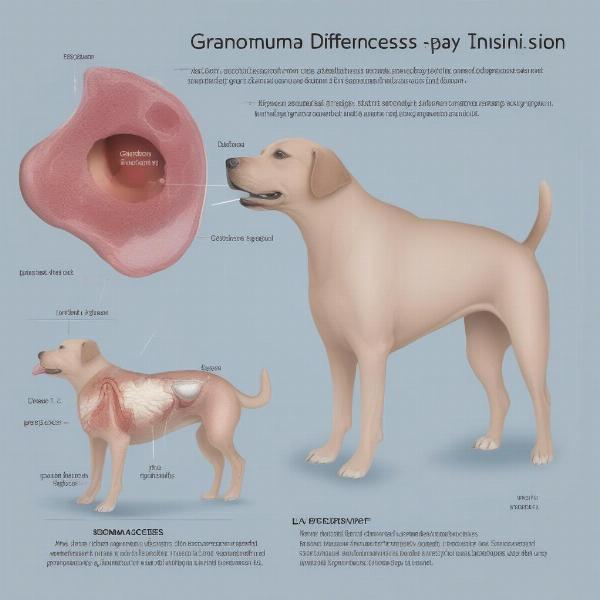Discovering a lump near your dog’s spay incision months after the surgery can be alarming. While often benign, it’s crucial to understand the potential causes and when to seek veterinary attention. This article will explore the reasons behind these lumps, offer advice on monitoring them, and explain when professional help is necessary.
Understanding Post-Spay Incision Lumps
Several factors can contribute to lump formation near a spay incision site months after the procedure. These include seromas, granulomas, and, less commonly, abscesses or even tumors. It’s important to remember that not all lumps are cause for immediate concern. However, correctly identifying the type of lump and monitoring its development is key to ensuring your dog’s health and well-being.
Common Causes of Post-Spay Lumps
-
Seromas: These fluid-filled pockets develop under the skin and are a common complication of surgery. They are typically soft, fluctuant, and non-painful. Small seromas often resolve on their own, but larger ones might require drainage by a veterinarian.
-
Granulomas: These firm, raised nodules form as a result of the body’s inflammatory response to suture material. They can appear months after surgery and are usually not painful. While some regress over time, others might require surgical removal.
-
Abscesses: These are pockets of pus caused by bacterial infections. They are usually warm, painful, and may be accompanied by redness and swelling. Abscesses require veterinary attention and often necessitate antibiotics or drainage.
-
Tumors: While less common, tumors can also develop near the incision site. These can be benign or malignant and require veterinary diagnosis and treatment.
 Different Types of Post-Spay Lumps
Different Types of Post-Spay Lumps
When to Seek Veterinary Attention
While many post-spay lumps resolve on their own, some require professional intervention. Consult your veterinarian if you notice any of the following:
- The lump is growing rapidly.
- The lump is painful or hot to the touch.
- The incision site is red, swollen, or discharging pus.
- Your dog is exhibiting signs of illness, such as lethargy, loss of appetite, or fever.
- You are simply concerned about the lump’s appearance.
Monitoring Your Dog’s Spay Incision
Regularly checking your dog’s spay incision, especially during the initial healing period and in the months following, is essential. Gently palpate the area for any lumps, bumps, or changes in texture. Note the size, shape, and consistency of any lumps you find, and monitor them for any changes. Early detection and prompt veterinary care are crucial for addressing potential complications.
Conclusion
Discovering a lump near your dog’s spay incision months later can be concerning, but it’s important not to panic. While some lumps are benign and resolve independently, others require veterinary attention. Regular monitoring, understanding the potential causes, and knowing when to seek professional help are key to ensuring your dog’s health and well-being after spaying.
FAQ
-
How long does it take for a spay incision to heal completely? Generally, a spay incision takes about 10-14 days to heal externally, but complete internal healing can take up to six months.
-
Is it normal for a spay incision to be slightly raised? A small amount of raised tissue is normal, especially during the initial healing phase. However, if the raised area continues to grow or changes significantly, consult your veterinarian.
-
Can I massage my dog’s spay incision? Generally, it’s best to avoid massaging the incision area unless specifically instructed by your veterinarian.
-
What should I do if my dog licks her spay incision? Excessive licking can disrupt healing and increase the risk of infection. Use an Elizabethan collar to prevent licking.
-
When should I remove my dog’s stitches after spaying? Suture removal typically occurs 10-14 days after surgery. Your veterinarian will schedule a follow-up appointment to remove the stitches.
-
Can my dog develop a seroma years after being spayed? While less common, seromas can occasionally develop months or even years after spaying.
-
Are granulomas cancerous? No, granulomas are not cancerous. They are a benign inflammatory reaction to suture material.
About ILM Dog
ILM Dog (https://ilmdog.com) is your trusted international resource for comprehensive dog care and breed information. We’re dedicated to providing practical, expert-driven advice on dog health, nutrition, training, grooming, and product recommendations. Whether you’re a seasoned dog owner or just starting your journey, ILM Dog offers valuable insights and resources to help you provide the best possible care for your canine companion. For expert advice or to learn more about our services, contact us at [email protected] or call +44 20-3965-8624.